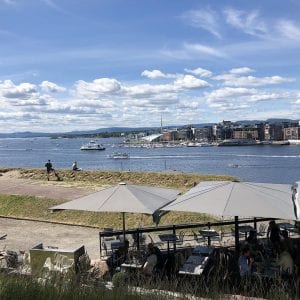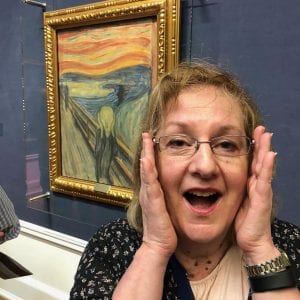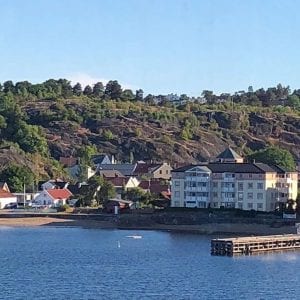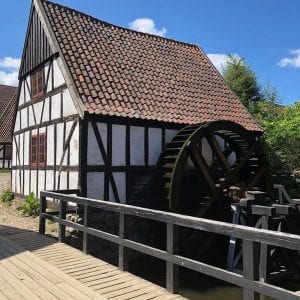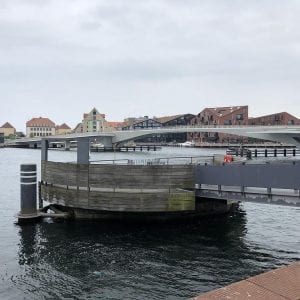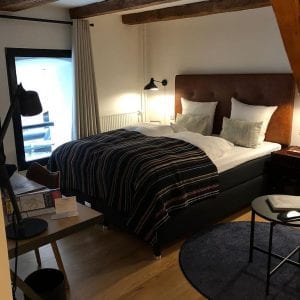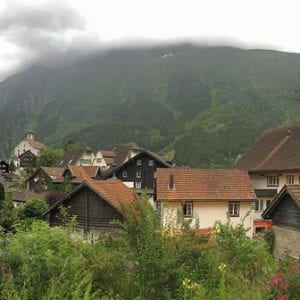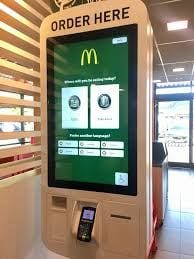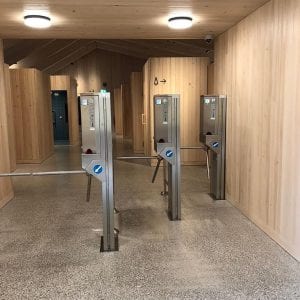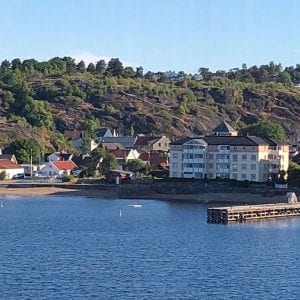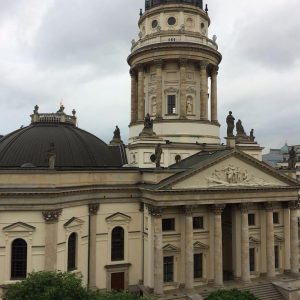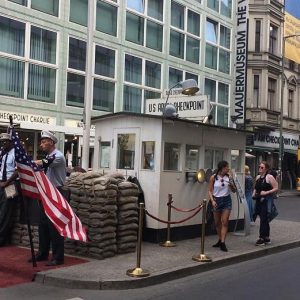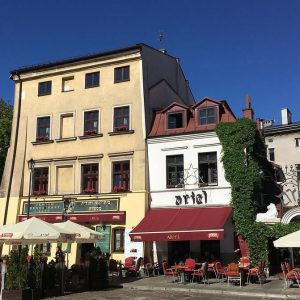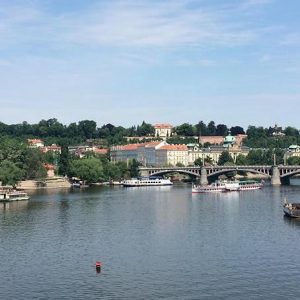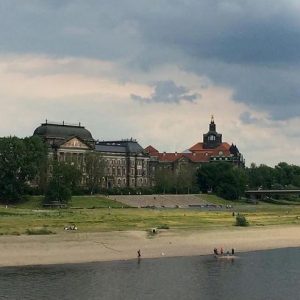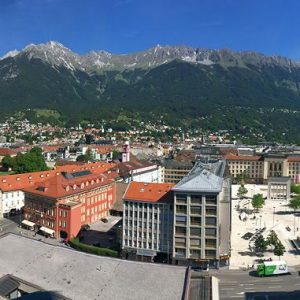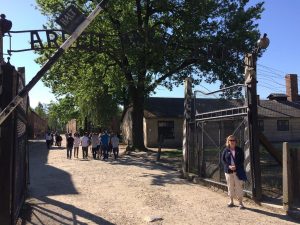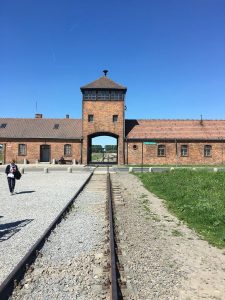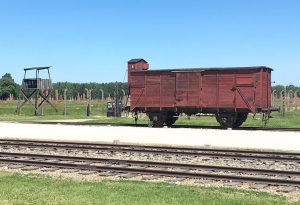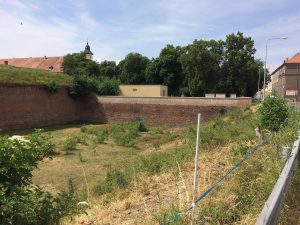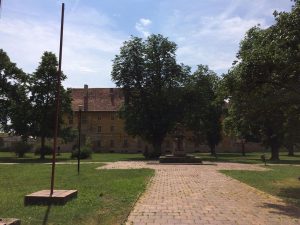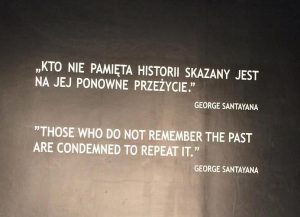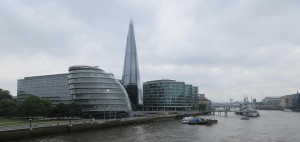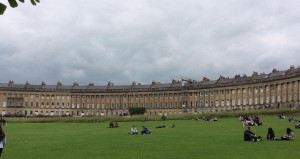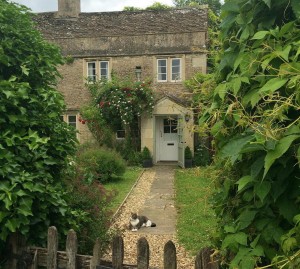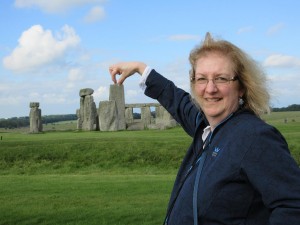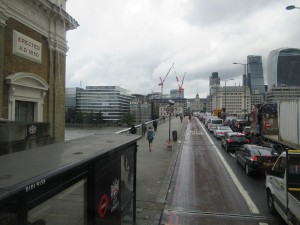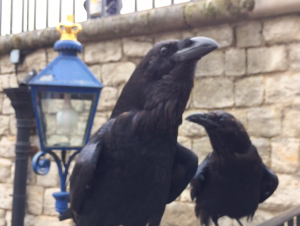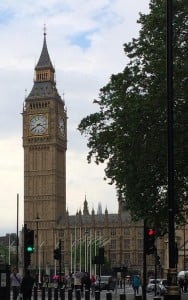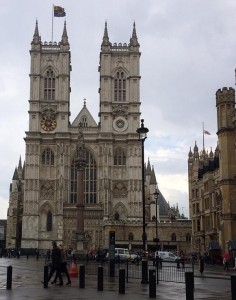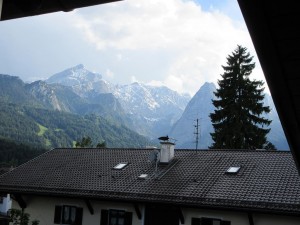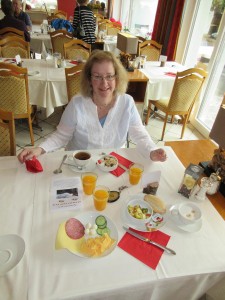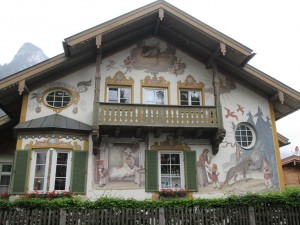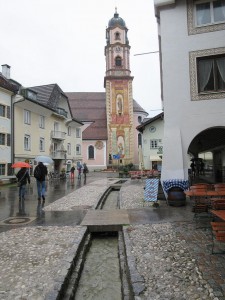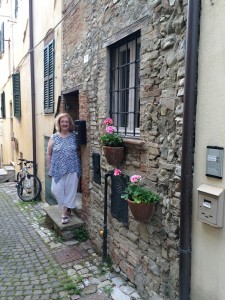Author Archives: shoulded
The Final Destination for Anne Frank
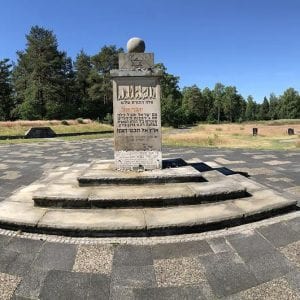
Bergen-Belsen Memorial
Famous diarist Anne Frank was born in Frankfurt, Germany, moving to Amsterdam when she was four. To try to save his family, spice merchant Otto built a small shelter for his family and several friends in the attic of his business. We visited this site in 2009 and anyone with interest in the subject should go there. The link will share a few of my thoughts.
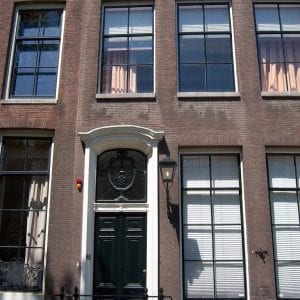
Anne Frank House in Amsterdam
When the family was discovered they were sent to a transport camp in the northern part of the Netherlands, Westerbork. We walked through this area on the same trip as Amsterdam.
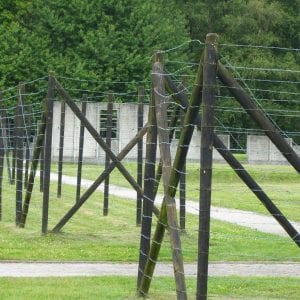
Transit Camp in Westerbork
From Westerbork, the Frank family as sent to Auschwitz like so many other European Jews. I wrote about this experience last year.
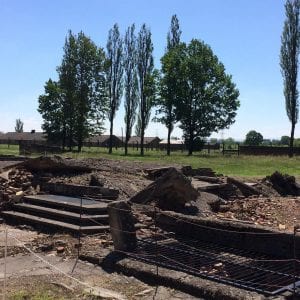
Auschwitz-Birkenau
When the British liberated the camp in April of that year they forced the SS left behind to bury thousands of corpses that were initially there as well as those that died during the liberation. After that the camp was destroyed to eliminate typhus.
Today, visitors can walk through the grounds which are a large memorial to those who were murdered. It is quite emotional. There are 13 burial mounds with anywhere from 1000-2500 bodies. Citizens have erected monuments and there is one for Anne and her sister Margot but they are not actually buried there. No one knows that information.
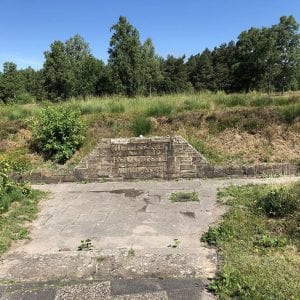
One of many burial mounds. This one holds 1000 victims’ remains.
The grounds also have intricate maps of what would have been where as well as a “Silent Room” where people can meditate and leave messages for the victims.
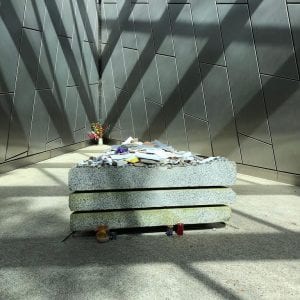
Silent Room
Bergen-Belsen does not include a fee asking for donations instead. This includes an extensive education center with many documents and movies taken by the British during arrival that help to understand the horrific conditions during this time period.
On both our visits first to Auschwitz-Birkenau and then to Bergen-Belsen we were blessed with sunny summer weather which seems incongruous with the events occurring in those places.
The Rest of the Story, Scandinavian Road Trip
Leaving Copenhagen we headed to Gothenburg, Sweden spending two nights and doing little but shopping and eating before we left for Oslo, Norway. An easy trip we followed major highways until reaching the capital city where a major beautification project has most of the city center under construction. BUT despite that Oslo is a lovely city. The people spoke English well, were proud of being Norwegians, and quite friendly. At this time of the year it is daylight almost all day so we never actually saw dark.
We discovered that a block from our hotel was the National Museum of Art which housed many famous paintings but its most iconic was “The Scream” by Edward Munch. The museum allowed photography and so like the leaning tower of Pisa, everyone had to stand beside of it and imitate.
I moved on the Norwegian Resistance Museum which was small but packed with many visuals and information to help understand how Norway fared during the Nazi occupation. Mike followed a short path away from the museum which led to an overlook of the bay. Our visit to this city was much too short and next time we will drive over to Bergen to enjoy a fjord cruise. The prices for this city were much more reasonable than Copenhagen.
After hour and a half drive, four hour ferry across the North Sea and a hour and a half drive south we arrive at Aarhus, Denmark, one of the oldest cities in Denmark. It is a great city to visit which many attractions. My favorite was the Marselisborg Deer Park where two types of deer, Sika and Dådyr run freely and will eat carrots right out of your hand. We stopped on the way to our hotel a with three apples and a bag of carrots. In fifteen minutes all of the food was gone. The next day we returned with two bags of carrots broken into small pieces. This allowed us to walk a lot further and see more of the park.
In the afternoon we traveled to Old Town, which is a park filled with old buildings that have been relocated to the area. In many are docents dressed period costume to help you understand life during that time period as well as shops and a nice café for lunch. This place could have been a full day’s trip.
Again, our American tendency to stay for only a little bit meant it was time to leave with much unseen BUT there are always future trips to be had!
Coping in Copenhagen
We chose to enter Denmark by ferry. Unless you do this regularly the ticket is rather pricey. It costs around a $150 for two people for an hour and forty-five minute trip. It was quite pleasant with sunny but cool temperatures. We met a German couple going on holiday to Sweden who explained what we needed to do which was quite helpful and we enjoyed a lively conversation for our crossing.
After docking we headed by car to Copenhagen, a two hour trip north. Unfortunately this part of the Danish interstate systems had next to no places to stop for personal needs and we found ourselves cruising the back roads in search of a bathroom. It wasn’t too long until we reached a gas station and all needs were met.
With research done previous to the trip and our navigator system we easily found the parking lot that would be needed to stay at our chosen hotel. A machine in the building allowed English as a language showing a photo our car as we entered the building; we then submitted credit card information, were given a receipt of time entered, and then went off in search of our hotel.
A pleasant walk along the canal and around the city opera house led to what had previously been two warehouses for Hong Kong exports. Converted now to quaint lodgings, the hotel still honors its past with Asian cuisine in their restaurant.
In the heart of the old city, we were perfectly located. There are many restaurants and sites including the famous “Little Mermaid” statue situated in the harbor. The weather at this of the year tends to mild in the 60s but by the water it can be quite windy. I didn’t bring a hat so most of my photos include windblown hair.
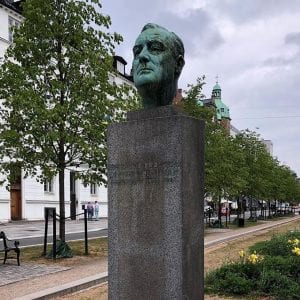
Mike: That looks like FDR Me: (After checking the plaque) It is! Not sure why this statue is in Copenhagen.
When we left the capital city, it was time to do clean our dirty clothes. Copenhagen has several locations of a British owned chain called Laundromat Café. The price to do laundry was quite reasonable. While we waited we treated ourselves to breakfast. The cost for meals in Copenhagen was quite high. Breakfast was around $40 and dinner $100 at casual places.
One final lesson before leaving for Sweden was how to handle the parking on the street next to the Laundromat Café. I downloaded an app and gave it my address. The app started timing. When we left, I turned it off and was charged a fee. I chose to pay with Paypal and all was well. This took some research but since we often don’t have coins for the country in which we are staying I found this helpful.
Road Trippin’ in Europe, Summer 2018!
This summer Mike and I decided to visit Scandinavia and because we had never seen the scenery and thought that a road trip would enhance the journey. Using a car for travel has its advantages in that you can see more things and are not beholden to a tight schedule BUT it has it challenges as well. The driver, in this case, Mike will be tired at the end of the day. Germany must be undertaking a major infrastructure project as everyone (and we went on many) of the autobahns that we traveled were under construction adding up to two hours to our daily travel. Maintenance of European highways are funded in part by tolls and vignettes. The following in no particular order are some of my take-aways that might help if you ever plan to travel in Europe by car (or any other mode of transportation).
- Vignettes are a road tax that some European countries might use instead or in addition to tolls. This trip we traveled through two countries that use this type of funding. In Austria the vignette cost was about $10 and can be bought at gas stations in Italy before you enter. You place the sticker on the driver’s side of the car in the front window. It covers a particular period of time, in this case ten days. Austria also used tolls. Switzerland pulls cars over as you enter the country and charges $42.00 but it lasts a year. We bought both vignettes with credit cards which is good as Switzerland does not use Euros and we were only passing through the country, staying long enough to eat dinner.
- Tolls can also be paid with credit cards. Italy uses the toll system and you will pay at least $30 if you drive around on the Auto Strada much. Norway uses an electronic toll system so we aren’t sure yet what we will owe. A photo is sent to where the car is registered and in our case that would be the Europe Car rental place.
- All of the countries we travel through have rest stops, which include gas stations, a restaurant, bathrooms or WC as they are referred to, and some have fast food like McDonalds or Burger King. We enjoy these places as we don’t have to leave the interstate and try to locate what we need. ALL of the McDonalds in Europe have kiosks which allow you to order in English, pay for it, and pick up your food at the counter or have it delivered to your table. I really don’t understand why this hasn’t caught on in the states. Even when places are crowded we have gotten our food in a timely fashion. Their restaurants are often cafeterias that serve food that is quite good. Marche is one such chain that charges by the plate size. Using restrooms in Germany and Switzerland costs money, typically 70 cents. You will receive a 50 cent coupon to be used for in the shop if desired. You can accrue them and use more than once. They are usually very clean.
- We stayed in a combination of hotels. To maintain our Hilton Diamond Status and receive their perks which are considerable in Europe, we use this chain wherever they exist, which is usually in large cities. In smaller towns and all of Scandinavia I used TripAdvisor to locate budget friendly hotels and after choosing the place, used Booking.com to reserve the room. TripAdvisor has begun allowing patrons to book through them but I found they wanted payment up front and I want to privilege of changing my mind. We stayed at nine different lodgings and they all met my expectations in cleanliness and comfortability.
- European hotels, especially those not associated with an American chain are usually smaller than American hotels. A double is two beds pushed together with a sheet and a duvet. Sometimes there is a piece of fabric that runs across the end of the bed for decoration and decorative pillows. European hotel pillows are usually filled with feather and somewhat flat. A number of the places we stayed had extra pillows available. Many of the hotels do not offer wash clothes, facial tissue, or clocks. I use one of the hand towels as a wash cloth, carry tissues with me, and look at my cell phone for the time. We stayed at a place this time that did not include a shower rug but they issued us an extra hand towel in its place. Many offer complimentary water because Europeans tend to drink bottled water instead of tap water. Internet was free at all of the places and usually good.
- Breakfast was part of the price at all but one of the places we stayed. A European breakfast is large having cereals, yogurt, fresh fruit, breads/pastries, deli meats and cheeses, tomatoes and cucumbers, as well as hot food like eggs, sausages, bacon, beans, etc. Many offer fresh orange juice, a selection of coffees like cappuccinos, and tea. In Norway they served reindeer meat in gravy. I declined this option but had a piece of the homemade chocolate they served instead.
- I have read in many places that European portions of food are smaller than in the states. I have really not found that to be true. Mike and I often share an entree and add dessert. There a NO free refills on drinks so sodas are a poor choice in Europe. Opt for water instead.
- Copenhagen is a very expensive place to visit. We averaged about $150-$200 a night for hotels on this trip and two of them were under a $100 but in Copenhagen we paid $400 a night with no breakfast as that cost an extra $44 a person per day. The room was lovely, in the center of everything we wanted to see, and by the water but we paid for that privilege. Oslo, Norway was just as much fun and cost way less.
- When traveling by car, a navigator system is a must and a European cell phone data plan a help. The navigator system chose the fastest way to get from one place to the other, even when it meant stopping in traffic jams and helped to get into and out of large cities with small streets. We used our cell phones to find shopping and dinner choices. Side note: Bicycles are very popular in Europe so you will have to watch for those when you drive as well as other hazards.
- Our trip to Scandinavia required two ferry rides. I learned that it is best to book ahead. One of the rides was four hours long so I paid extra for business class. I was glad to do it because we had to get up at 4:15 to get to the port on time and recliners in this area allowed for napping. Both ferries offered food and drink.
- Always try to book in advance tickets for popular tourist places. We have done this in the past for art museums in Florence, the Sistine Chapel in Rome, and the Anne Frank house in Amsterdam. The ticket reserves you a time and you can skip the long lines that are often in the hot sun. This trip we found that the National Art Museum in Oslo was a block away and already had a line ten minutes before opening but because it is not as famous as the places I previously listed, we got in just fine.
We are very glad we took this trip but on the ferry over to Denmark, a German couple made an accurate observation that Americans tend to spend little time in one place preferring to move on. We were living proof of that so we feel we got an overall impression which was short of details. Our next trips will involve less moving around and more exploration of one place. One of my favorite lodgings was in the countryside of Lower Saxony in Germany. It was small resort/conference center and was very peaceful and quiet. I am looking forward to staying at more places like that.
The Beauty of Eastern Europe
This year’s travels began in Berlin, specifically what was formerly East Berlin. A few blocks from our hotel is the iconic “Checkpoint Charlie,” the point where East and West Berlin met during the Cold War. The area has colored piping that helps to visualize where the Berlin Wall existed. This part of the city is a combination of the old and new, shoppes beside of old churches for example.
After a short visit that included a “Third Reich” day tour concluding with an unexpected sighting of German Chancellor, Angela Merkel, we headed on to Poland. After 30 minutes of a very rough road, we merged into a nice highway and the rather flat farmlands of Northwest Poland. We stayed in Krakow more as a base to travel to Auschwitz rather than to tour the city itself. In fact our hotel was several miles away from downtown. It was quite charming though. We managed to find parking to eat in the Jewish district but were not successful when wanting to see the old section of town or the River Vistula.
Onward to the Czech Republic, specifically Prague. The area was similar to Poland with a few more rolling hills. We stayed in the Old Town and my photos do little to show the beauty of this area, street after street of colorful old buildings.
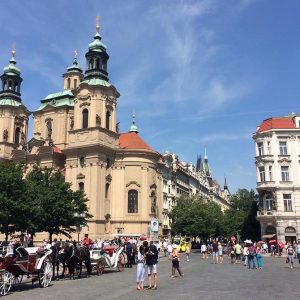
A glimpse into the Old Town Square, site of the famous astronomical clock that unfortunately was covered for restoration
We traveled from Prague two hours northwest to Dresden, Germany, the site of much bombing from the allies during WWII. I was surprised by how the German people recovered the stones and began restoration of the century years old buildings. Much of it came after the end of the Cold War and still continues today. Again, we were fortunate to find a hotel in the Old Town along the Elbe River.
We found the people in all three countries to be friendly and helpful despite language barriers. The food was excellent. I am not a fan of some of the Eastern European gravies but that was a minor problem. ALL had delicious sweets, so dessert was always a treat.
The Past Meets the Present
After many years of trying to understand, I arrived at Auschwitz, the place of horror described in so many of the books I have read. Renown author Elie Wiesel’s words from Night come to mind, “In front of us, those flames. In the air, the smell of burning flesh. It must have been around midnight. We had arrived. In Birkenau.”
Due to the nature of the visit my reflections have taken time. Returning to my hotel in Krakow, I fell into bed and didn’t awake for twelve hours, not a common practice for me. My thoughts keep returning to the site that on a beautiful sunny day seemed harmless.
Located in Poland by the town of Oświęcim, the Germans renamed the area that is comprised of two large camps and several sub-camps. Auschwitz I is characterized by the infamous “Arbeit macht frei” sign that tells everyone who enters “Works sets you free,” though most of the time freedom came only with death. This camp is comprised of brick barracks that were initially home to political prisoners and Poles. Today they hold artifacts that teach of the daily life inside the place of terror.
Within a few yards of the the camp and the gas ovens is the quarters of the longest serving camp commander Rudolf Höss, whose children played while men and women were tortured and killed.
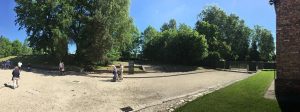
House is to the far right behind trees, camp is just behind the photographer, and the ovens are to the far left.
Auschwitz II, better known as Birkenau, was created to meet the needs of the Nazi’s final solution. A train track divides the women’s and men’s wooden barracks and ends a short distance from the gas ovens and crematoria. This is where selections were made and for most of the 1.3 million who entered the camp, their final stop. As with many of the things I have seen, the place is smaller than I’d imagined. It boggles the mind to think of the 1.1 million Jews, Poles, Soviets, Roma, Jehovah’s Witnesses and others who were forced to enter and ultimately murdered introduced with these words, “You are now in Auschwitz Concentration Camp and the only way out of her is through the crematory chimney.” Karl Fritzsch (SS-Hauptsturmführer)
Five and a half hours northwest in the Czech Republic is Terezin or as the Germans called it Theresienstadt. Terezin was built as a fortress city in that latter part of the 18th Century and today is still surrounded by a grassy moat. The entire town was converted into a ghetto for Jewish families. The moat was used to grow food for the German workers while the Jewish citizens starved.
The camp is unique in that many children lived there. Schools were set up and the children left behind evidence of their existence through writings and drawings. A cultural center attempted to create a life for the citizens with plays and musicals being performed. When the International Red Cross asked to see a concentration camp this is where they were sent. Some of the residents tried to smuggle artwork that depicted the real conditions the prisoners faced but their attempts failed. The drawings weren’t found until after the war and the heroic artists were tortured and killed.
Most of the residents of Terezin were eventually sent to Auschwitz. When the Russian troops advanced some of the Jewish prisoners were returned to Theresienstadt where a Typhus epidemic took many of their lives.
The lesson in all of this is to remember. Remembering ensures that the victims died for something. Remembering helps us to understand that this is what happens when people fall for false words and selfishness. That this began in Germany, a nation known for their philosophical, scientific, and artistic advances is important. If it can happen there, it can happen anywhere.
One of the first steps in repeating this horror is the inclination to dehumanize classes of people. Recently liberals were called out with the statement, “They’re not even people. (1)” Nour Kteily, a psychologist at Northwestern University found that when asked about the evolution of man, “on average, Americans rate other Americans as being highly evolved, with an average score in the 90s. But disturbingly, many also rated Muslims, Mexican immigrants, and Arabs as less evolved.” This kind of thinking leads to support for ideas such as a Muslim ban, with the article concluding “People who dehumanize are more likely to blame Muslims as a whole for the actions of a few perpetrators.” (2) British politician Nigel Farage threatened that if not enough is done to fight terrorism that internment camps for Muslims might be an option. This idea was quickly supported by elements of the conservative media. (3)
The recent elections of populist candidates demonstrate that people today are comfortable listening to what they want to hear. The term fake news is often a synonym for propaganda, which remains an effective means to persuade.
1938: “I overcame chaos in Germany, restored order, enormously raised production in all fields of our national economy…I succeeded in completely resettling in useful production those 7 million unemployed who so touched our hearts…” (4)
2017: “Never has there been a president — with few exceptions, in the case of FDR, he had a major Depression to handle — who’s passed more legislation, who’s done more things than what we’ve done,” Trump said. “I think we’ve been about as active as you can possibly be at a just about record-setting pace.” (5)
So today, more than ever, it is important to remember the words of Confucius. “Study the past if you would define the future,” or Santayana.
- http://www.independent.co.uk/news/world/americas/us-politics/eric-trump-democrats-not-even-people-comments-sean-hannity-fox-news-interview-video-watch-a7777416.html
- https://www.vox.com/science-and-health/2017/3/7/14456154/dehumanization-psychology-explained
- http://www.salon.com/2017/06/09/conservative-media-call-for-internment-of-muslims-following-london-attacks_partner/
- http://www.spiegel.de/international/germany/the-fuehrer-myth-how-hitler-won-over-the-german-people-a-531909.html
- https://www.washingtonpost.com/news/post-politics/wp/2017/06/12/trump-touts-amazing-progress-basks-in-praise-of-his-cabinet/?utm_term=.b544004c232e
Lessons Learned from London
London is undoubtedly the busiest and complex city I have ever visited. I am glad I got to spend some time there but a second future visit is in order. These are some things I learned.
- I am usually so good about investigating new places; I did not do my usual work and it showed. Knowing what you want to see and where these things are located helps in deciding lodgings. I chose somewhat poorly, which leads to…
- Lodge some place central to what you want to see and public transportation stations.
- Learn in advance or take some time before you begin site seeing to orient yourself to the public transportation. In London realize that bus stops will be located on the opposite side of the road than you may be used to.
- If you want to take a tour or two, book those first. Then choose possible items like a City Pass that gives you substantial discounts and options to skip long lines. I did the opposite and lost one day on a three-day pass.
- Keep ALL ticket stubs. Without going into a long drawn out tale of woe, a return train ticket was lost costing us around $25 extra dollars.
- Remember if you try to see it all, there will be no reason to return. (I keep saying this mantra in my head.)
- Finally, if you want to see what England is all about, leave the big city. As with many large metropolises, London is filled with sky scrapers, construction, and lots of people. It was only on a day trip to Bath that I began to see what I had imagined through books and television.
Despite all of my mistakes, we did enjoy the sites, especially our day trip to the west country. Bath was settled by the ancient Romans but all of their remains are buried underground. We would have had to tour the museum to see any. It is predominately decorated in the style of the 18th century, multi-storied, large identical houses, connected together, many in circular fashion. In modern times a great deal of these houses have been divided into apartments. Our tour guide informed that if we looked closely we would see several windows that had been bricked. At one time taxes were based on the number of windows one had. When that rule expired another one took its place and that restricted renovations that were not historically accurate so for the most part once a window was bricked, it must remain that way. The downtown area is filled with shops and since the native language is English, the book store is the place I enjoyed the most. It was tiny and filled with nooks and crannies but just as I was about to leave hands empty, I noticed a set of Kate Atkinson choices, an English author I enjoy and sure enough they had a copy of a book that Amazon does not carry. What a find!
Another short stop on our tour was Lacock, a small village owned by the British Heritage Trust. It looks like it stopped growing the 19th century. People are allowed to live there within certain conditions but because of its unique nature, Lacock is popular with the film and television industry. Harry Potter’s birthplace resides there as well as a street used for a marketing scene in last year’s “Downton Abbey.” The town is small and I do so wish they would mandate that all cars be parked outside of town because they really took away from the quaintness of it all.
As evening came we found ourselves at Stonehenge. A day that had been cloudy and rainy suddenly changed and the stones were bathed with sunlight. Despite the onslaught of tourists, the scene is spiritual. Thousands of years ago, sophisticated beings found a way to haul tons of stones from 150 miles away in Wales to central England and place them in a very intentional pattern. Their purpose holds much debate but the fact that the place exists is what makes it special.
Finally, and for most you won’t understand but I really enjoyed watching television in the hotel room at night. Having access to all of the BBC and ITV channels I could enjoy shows that I have to wait on for Netflix or PBS to carry or read about them and not see them at all. I am a big fan of these channels.
Tower, Thames, and Time Piece, Oh, My!
Our first trip to London, what an eye opener! This is undoubtedly the busiest city I have ever visited and that includes New York and Rome. Cars, buses, and bicycles speed through the narrow streets of this city that easily blends the old with the new.
We began our day with a walk across the London Tower Bridge and then down to the London Tower. This complex with its beginnings in 1070 is notorious for imprisoning and executing such famous figures as Anne Boleyn and was home several times to Sir Walter Raleigh. He seemed to have problems getting along with Queen Elizabeth I but spent his time productively writing the first volume of his “History of the World.” I often find the small stuff to be quite entertaining and one of my favorite parts of the tour was getting up close and personal with real ravens. As a fan of Poe, this was quite exciting. Apparently these noisy birds are an essential part of the place.
Next up was a cruise down the River Thames. Our guide pointed out many places of interest including one of the oldest taverns in London, as well as modern structure called the Shard, a tall building that looks like a shard of glass.
We departed at the Westminster Station where Big Ben stood tall adjacent the large complex of parliament buildings. FYI – Big Ben is actually the bell that rings to tell the time. The clock tower was renamed to honor Queen Elizabeth II for her diamond jubilee.
Across the street is Westminster Abbey, renown for many things in modern times, including Princess Diana’s funeral and her son, Prince William’s wedding. It was indeed an inspiring tour through a beautiful building that is first and foremost a place of worship and then a burial place to people like Elizabeth I, Geoffrey Chaucer, and Sir Isaac Newton.
London is cloudy much of the time with rain a constant threat but it didn’t slow anyone down – you just prepare for it and if necessary take refuge with a cup of tea or a refreshing cider off the tap! Day One a success!
A Road Trip: Destination Bavaria
One of the nice things about where we live in Italy is its closeness to many different areas. Mike has been to Garmisch-Partenkirchen, Germany, a beautiful town in the Bavaria, several times but never has had time to be a tourist. So we decided a road trip was in order.
The area is surrounded by mountains, the Zugspitz being the highest point in all of Germany. The hotel rooms were built with small balconies that afforded views of the local scenery. While we could see the Zugspitz, the Alpsptiz, was the most notable peak that appeared from our room.
Mike had been carrying some items to place in geocaches. He believed that this would be just the area to leave them. With app in hand, we proceeded to a field between Garmisch and Oberammergau. I stayed with the car as Mike traveled a path to a point to where a small chapel and bridge intersected. He spent some time looking but realized that where he thought the cache was would mean him getting wet. He took several photos and finally decided he wasn’t prepared for this particular one. Later after successfully depositing his items at another spot, he looked at his camera. Clearly shown there was the first cache, with the glare of the sun, Mike had been unable to see it but could now claim credit for “finding” it. 😀
The town of Oberammergau is typical of the area. Many of the houses and public buildings have frescoes that depict various religious themes. The one in this photo is a school. Look carefully and I think you can figure out what is going on. The rest of the story was on the side of the building. The town is famously known for a passion play presented every ten years with hundreds of performers as well as real animals. We are hoping to be able to see the next one in 2020.
Both days of our visit were rainy so Mike’s desire to go to the top of the Zugspitz had to be put on hold. The rain prevents the panoramic views, so we decided to visit Mittenwald, another quaint town. A difference here were small canals that ran along the side walks.
For the two days we drove and walked through the area, we ate our fill of Germany meats, breads, and sweets, Mike got to practice his German, and both of us enjoyed the beauty of Bavaria. We departed for home quite satiated, realizing we were back in Italy when during a lunch stop, a television in the room was showing “The Simpsons” dubbed in Italian. I mean where else is something so anachronistic going to appear?? Such is life in Italia!
The Fourth Time’s A Charm!
This is the fourth summer we have spent at our modest home in Umbertide. By this time little rituals have sprung forth. At the Wednesday market we chose from the various multi-colored petunias and geraniums deciding on the perfect ones to sit outside in the window boxes located on each floor of the building. This year we were offered pink and white speckled geraniums. They go in the planter outside the kitchen window. The frequent thunderstorms have yielded water but the blossoms have suffered a bit from the winds.
Less fun is paying yearly taxes. First we have to find out where to pay them. Each year seems to hold a different location. 2016 – the post office. This is a short drive away. Once there we have to decide which button will give the correct ticket for service. Luckily a young woman was able to help. We then had to stand for about thirty minutes until our number was called. Surprisingly many numbers were called and no-one showed up. I am not sure whether the machine had problems or people got tired of waiting. We again lucked out as the person helping knew what he was doing and our transaction took little time, not so for several others.
After that we hurriedly left to return some extension cords (wrong plug size) to a department store about 30 minutes away. Traffic road work held us back and I wasn’t sure we would make the 12:30 closing. Many stores in Italy close from 12:30 to 4:00. We made it to Casagrande in time but another thing typical of Italy is that many businesses are closed on Monday morning, Casagrande being one of them. We decided to take a photo so information will always be close.
One man’s disappointment can be another’s opportunity. Turning around to go back, I noticed a sign to a store I had never heard of before. We followed the signs and ended up at a new shopping centre. It was shopper’s haven, many different kinds of stores, most being in the modest price range, including an assortment of eateries. Yum.
Due to the large lunch, we returned to another ritual and that is gelato for dinner. There are two shops in walking distance. One offers a nice patio, friendly owners, and generous portions. The other is a shorter walk and a bit richer offering.
While the rituals keep one grounded, it is the unusual that keeps one attuned. As a joke to keep me from enjoying half a pastry for breakfast one morning, Mike said, “Look at the band coming down the street.” Of course I looked, as Mike stole the treat. I looked because it is not unusual to see a band coming down the street and sure enough the next evening, I heard music and there was the band. What got me laughing though, was they played “When the Saints Go Marching In,” – not an expected selection on an evening in Umbria!
